|
|
|
Sort Order |
|
|
|
Items / Page
|
|
|
|
|
|
|
| Srl | Item |
| 1 |
ID:
159308


|
|
|
|
|
| Summary/Abstract |
The authors examine foreign countries' cability to conceal nuclear weapons tests both at the equipped test sites and beyond them taking into account the capabilities of the International Monitoring System.
|
|
|
|
|
|
|
|
|
|
|
|
|
|
|
|
| 2 |
ID:
152052


|
|
|
|
|
| Summary/Abstract |
After participating in the negotiations on the Comprehensive Nuclear-Test-Ban Treaty at the Conference on Disarmament in Geneva, I was elected the first executive secretary of the organization and started my work in 1997. At that time, we hoped that the treaty would enter into force only a few years after the International Monitoring System would be working. But today, twenty years after opening for signature, we are still waiting. The reason is a rather complicated formula for entry into force: all states with nuclear capabilities at the time of the treaty's negotiation must ratify.
|
|
|
|
|
|
|
|
|
|
|
|
|
|
|
|
| 3 |
ID:
152057
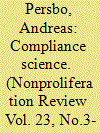

|
|
|
|
|
| Summary/Abstract |
The Comprehensive Nuclear-Test-Ban Treaty's verification regime is arguably one of the most effective and efficient systems of arms-control and disarmament monitoring in operation today. The science and technology underpinning the system have been developed over several decades. This article goes through the treaty's international monitoring system and pays particular attention to its waveform-monitoring techniques. It then considers the concept of data fusion, before describing the agreement's on-site-inspection mechanism. It briefly discusses how alleged noncompliance is likely to be resolved. It concludes by arguing that the treaty's verification regime is expected to make cheating costly, which enhances the treaty's deterrent effect.
|
|
|
|
|
|
|
|
|
|
|
|
|
|
|
|
| 4 |
ID:
152064


|
|
|
|
|
| Summary/Abstract |
The fate of the Comprehensive Nuclear-Test-Ban Treaty (CTBT) is closely connected to US attitudes toward the treaty, which in turn depend upon US perceptions of how the treaty affects US security. There have been wild swings in these perceptions since the treaty was signed in 1996. Impressive progress has been made in the ability to verify the CTBT in recent years, both in the International Monitoring System and in the possible use of on-site inspections. Questions remain in the minds of opponents regarding the treaty's possible effect on the US nuclear stockpile, as well as the treaty's overall relationship to nonproliferation. The new Trump administration will need to decide how to proceed on this crucial piece of unfinished business. In addition to finally ratifying the treaty, other options are possible.
|
|
|
|
|
|
|
|
|
|
|
|
|
|
|
|
| 5 |
ID:
152063
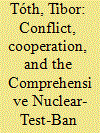

|
|
|
|
|
| Summary/Abstract |
The methods and concepts used to monitor and predict economic trends can offer a helpful approach in determining the future of the nuclear-test-ban regime. Like the global financial and economic markets, competitive security can be viewed as undergoing “boom-and-bust” cycles, wherein “overinvestment” in competition will inevitably result in a “burst bubble,” which prompts “regulatory” mechanisms to reign in competition through cooperative measures. These conceptual models offer some utility in understanding international security and the prospects for achieving entry into force of the Comprehensive Nuclear-Test-Ban Treaty.
|
|
|
|
|
|
|
|
|
|
|
|
|
|
|
|
| 6 |
ID:
152060


|
|
|
|
|
| Summary/Abstract |
The June 13, 2016, ministerial meeting of the Preparatory Commission of the Comprehensive Test-Ban Treaty Organization marked the twentieth anniversary of the signing of the treaty and the establishment of the commission. The ministerial sent a strong signal of political support for and commitment to the treaty. Ministers noted with appreciation the organization's achievements related to the detection and deterrence of nuclear-test explosions while also regretting the delay in ratification by the Annex II states. The ministerial emphasized, as the key parameters of the future strategy, the importance of a multilayered approach, including the importance of track-two diplomacy and the use of communication technology that did not exist twenty years ago.
|
|
|
|
|
|
|
|
|
|
|
|
|
|
|
|
| 7 |
ID:
152065
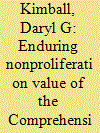

|
|
|
|
|
| Summary/Abstract |
Twenty years after the opening for signature of the CTBT, the treaty has near universal support and has established a global norm against nuclear-test explosions. The nuclear-testing taboo impedes the development of new and more advanced nuclear-warhead designs, which helps prevent dangerous nuclear competition and maintain international security. The treaty's international test-monitoring regime is nearly complete and already detects and deters clandestine nuclear explosions, even ahead of entry into force of the treaty. The UN Security Council's adoption in September 2016 of a resolution on the test ban has reinforced the norm against testing and reaffirmed global support for the treaty. But in order to realize the full potential of the treaty and close the door on testing, states need to undertake new and sustained diplomatic efforts that underscore the political and security value of the treaty for each of the hold-out states.
|
|
|
|
|
|
|
|
|
|
|
|
|
|
|
|
| 8 |
ID:
152055
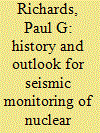

|
|
|
|
|
| Summary/Abstract |
Modern methods of nuclear-explosion monitoring are vastly more capable than they were when underground nuclear testing began in the late 1950s, in part because a cycle of improvements in explosion monitoring in the 1960–80 period led to improvements in monitoring for earthquakes and other phenomena, which then led to a general growth in monitoring assets that in turn has been applied back to explosion monitoring. Practical experiences in nuclear-explosion monitoring, acquired during the era of active testing prior to finalization of the CTBT text in 1996, laid the basis for monitoring in support of this arms-control initiative. This article elaborates on the future of nuclear-test-monitoring technology, which can build upon an additional and remarkable growth of general monitoring assets that began in the 1990s, largely unrelated to the specifics of nuclear-test monitoring. A new cycle of improvements in earthquake monitoring is likely to improve monitoring for explosions. While it is not easy to quantify the degree of monitoring improvement afforded by such new assets, an example from North Korea indicates the improvement can be substantial.
|
|
|
|
|
|
|
|
|
|
|
|
|
|
|
|
| 9 |
ID:
152062


|
|
|
|
|
| Summary/Abstract |
Ambassador Jaap Ramaker of the Netherlands served as chairman of the Comprehensive Nuclear-Test-Ban Treaty (CTBT) negotiations. In this article, Ambassador Ramaker reflects on the negotiating process and the ways in which concrete progress of the CTBT ratification process could enhance international peace and security. Ratification by the two remaining nuclear-weapon states would constitute an essential first step and also create a possible area of cooperation between Russia and then United States on a nuclear issue that, for these two states, has long been non-controversial.
|
|
|
|
|
|
|
|
|
|
|
|
|
|
|
|
| 10 |
ID:
182647


|
|
|
|
|
| Summary/Abstract |
This article provides an inside view of the sustained effort by the Group of Scientific Experts (GSE) which was key to the development of the international seismic network included in the 1996 Comprehensive Nuclear-Test-Ban Treaty (CTBT). Over the course of the GSE’s twenty-year-long journey, part of which was at the height of the Cold War, the GSE went from being a little-known entity that reviewed and encouraged research to designing and testing elements of a seismic verification system. Their work eventually included full-scale testing of the seismological component of the final global system that is now implemented by the Preparatory Commission of the CTBT Organization. The other three monitoring networks comprised in the treaty—radionuclide, hydroacoustic, and infrasound—are modeled after the seismic network. The article identifies some key conditions that made GSE a successful endeavor. Prime among these was the strong engagement among scientists and scientific institutions in many countries that contributed large resources. The formal work at the Conference on Disarmament in Geneva was just the tip of the iceberg, but very important. This official intergovernmental framework provided a connection to the political community, and a frame for organizing extensive global development and testing activities. GSE was given long-term mandates and self-determination of management and leadership, facilitating a sustained and goal-oriented process. Based on their leadership experience in the GSE and the CTBTO Preparatory Commission Verification Working Group, the authors also provide some reflections on how the concept of scientific expert groups and new scientific developments could prove useful in future efforts toward nuclear-disarmament verification.
|
|
|
|
|
|
|
|
|
|
|
|
|
|
|
|
| 11 |
ID:
073394


|
|
|
| 12 |
ID:
073393


|
|
|
| 13 |
ID:
157827
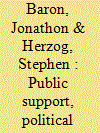

|
|
|
|
|
| Summary/Abstract |
The year 2016 marked twenty years since the Comprehensive Nuclear-Test-Ban Treaty (CTBT) opened for signature; the twenty-fifth anniversary of the US nuclear-testing moratorium occurred the following year. The international political climate, nuclear-explosion-monitoring capabilities, and US stockpile stewardship have all changed drastically since the US Senate voted against CTBT ratification in 1999, and they continue to evolve. Yet the most recent public-opinion survey on the test ban, showing 84 percent approval across the United States, dates to 2012. Do Americans still emphatically support the CTBT? To answer this question, we worked with the research firm YouGov to design and implement a new scientific survey assessing the current state of national opinion toward the test ban. Analyzing the survey results shows that, although US public support for the test ban remains strong, it has probably weakened since 2012. While political party identification is the best predictor of treaty support or opposition, a majority of Democrats, Republicans, and independents support ratification. However, many Americans remain undecided on whether the Senate should provide its “advice and consent” to ratification.
|
|
|
|
|
|
|
|
|
|
|
|
|
|
|
|
| 14 |
ID:
152061


|
|
|
|
|
| Summary/Abstract |
Twenty years after opening for signature, the Comprehensive Nuclear-Test-Ban Treaty still lacks the necessary ratifications to achieve entry into force. The United States is one of the remaining eight nations that needs to complete its ratification process, after the US Senate failed to provide its advice and consent to ratification to the CTBT in 1999. In order to secure that advice and consent now, the executive branch must engage both the American public and the Senate on the clear merits of the treaty.
|
|
|
|
|
|
|
|
|
|
|
|
|
|
|
|
| 15 |
ID:
152056
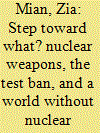

|
|
|
|
|
| Summary/Abstract |
Historically, nuclear-explosive testing was not required to develop simple, reliable, gun-type nuclear weapons with highly enriched uranium as the chain-reacting material. Testing may now not be required to build basic implosion weapons using plutonium. This suggests that, even if no state had ever conducted a nuclear test, a nuclear-armed world could still have emerged, but probably without thermonuclear weapons. The examples of the United States, Russia, the United Kingdom, France, and Pakistan suggest that, despite the twenty-year-old Comprehensive Nuclear-Test-Ban Treaty (CTBT), nuclear-weapon states with very different testing legacies expect to continue developing, and in some cases deploying, new nuclear weapons. The entry into force of the CTBT might not significantly constrain nuclear-weapons development for any state, and a worthwhile goal now may be to focus on other agreements to restrict nuclear weapon activities, in particular an agreement to ban nuclear weapons.
|
|
|
|
|
|
|
|
|
|
|
|
|
|
|
|
| 16 |
ID:
152054
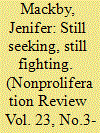

|
|
|
|
|
| Summary/Abstract |
Arms-control advocates have traveled a long road to end nuclear testing. Beginning with the US Baruch Plan and the Soviet Gromyko Plan in 1946, negotiations led to the signing of the Comprehensive Nuclear-Test-Ban Treaty (CTBT) in 1996. Two decades later, a verification regime is up and running, with most of a planned 337 facilities installed around the globe and sending information to a data center in Vienna. Large-scale on-site inspection exercises in Kazakhstan, Jordan, and elsewhere have shown that the planned procedures work. What is missing? Of the forty-four countries that must ratify the treaty for it to enter into force, eight still must proceed with their national measures for ratification. How and why did the negotiators end up with such an unwieldy provision? How did they design such a complex international monitoring system so quickly? This article delves into a brief history of the treaty and its negotiations, highlighting some of the key and most contentious articles of the CTBT, painstakingly arrived at. These include the basic obligations, entry into force, and certain verification issues, including on-site inspections. It also examines the interface of science and technology with diplomacy and politics. Senior diplomats and world-renowned scientists convened in Geneva day and night to hammer out the complex issues involved in verifying compliance with a test ban. They devised a regime that has exceeded their expectations.
|
|
|
|
|
|
|
|
|
|
|
|
|
|
|
|
| 17 |
ID:
073395


|
|
|
| 18 |
ID:
162685


|
|
|
|
|
| Summary/Abstract |
Relations between the United States and Russia are in a prolonged downward spiral. Under these circumstances, cooperation on nuclear issues—once a reliable area of engagement even in difficult political environments—has all but completely halted. There are urgent reasons to find a way out of this situation, particularly the expiration of the New Strategic Arms Reduction Treaty in 2021. However, seemingly intractable disagreements about noncompliance with the Intermediate-range Nuclear Forces Treaty and US ballistic-missile defense, compounded by the Ukraine crisis, the conflict in Syria, and the accusations of Russian interference in the US election of 2016, threaten the future of arms control. Against this backdrop, policy makers and practitioners should identify ways to re-engage on nuclear issues now so they can be ready to implement them as soon as feasible. This article considers how the Comprehensive Nuclear-Test-Ban Treaty (CTBT) could serve as a platform for US–Russia cooperation on nuclear issues when circumstances permit. Taking into account the challenges posed by ongoing US non-ratification, it identifies a menu of CTBT-related activities short of ratification that the two countries could undertake together. It explores how joint work on this issue would advance shared US and Russian interests while helping to create the circumstances necessary for further arms-control work.
|
|
|
|
|
|
|
|
|
|
|
|
|
|
|
|
| 19 |
ID:
091671


|
|
|
|
|
| Publication |
2009.
|
| Summary/Abstract |
The rejection of the Comprehensive Nuclear-Test-Ban Treaty (CTBT) by the U.S. Senate in October 1999 could have been avoided, and the consequences of that vote still loom in the minds of supporters of the treaty. President Barack Obama has embraced the vision of a world free of nuclear weapons, and a key element of the Obama administration's arms control agenda is delivering on U.S. CTBT ratification. In order to secure the two-thirds majority in the Senate necessary to ratify the treaty, senators that remain skeptical of nuclear disarmament must also be convinced that the entry into force of the CTBT is in the national security interest of the United States. This article provides an analysis of the issues surrounding U.S. CTBT ratification divided into three segments-verifiability of the treaty, reliability of the U.S. stockpile, and the treaty's impact on U.S. national security-and concludes that CTBT ratification serves the security objectives of the United States. The CTBT constitutes an integral component of the multilateral nonproliferation architecture designed to prevent the proliferation of nuclear weapons, and it constrains the qualitative development of nuclear weapons, thereby hindering efforts by states of concern to develop advanced nuclear weapons.
|
|
|
|
|
|
|
|
|
|
|
|
|
|
|
|
|
|
|
|
|